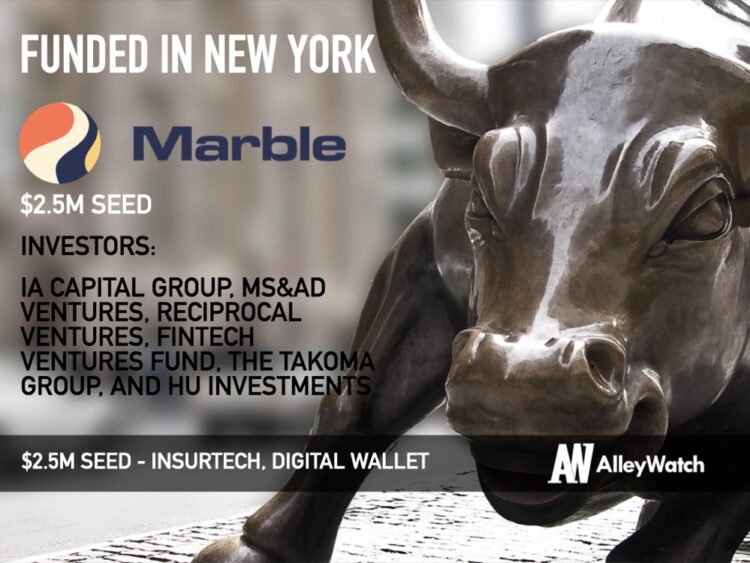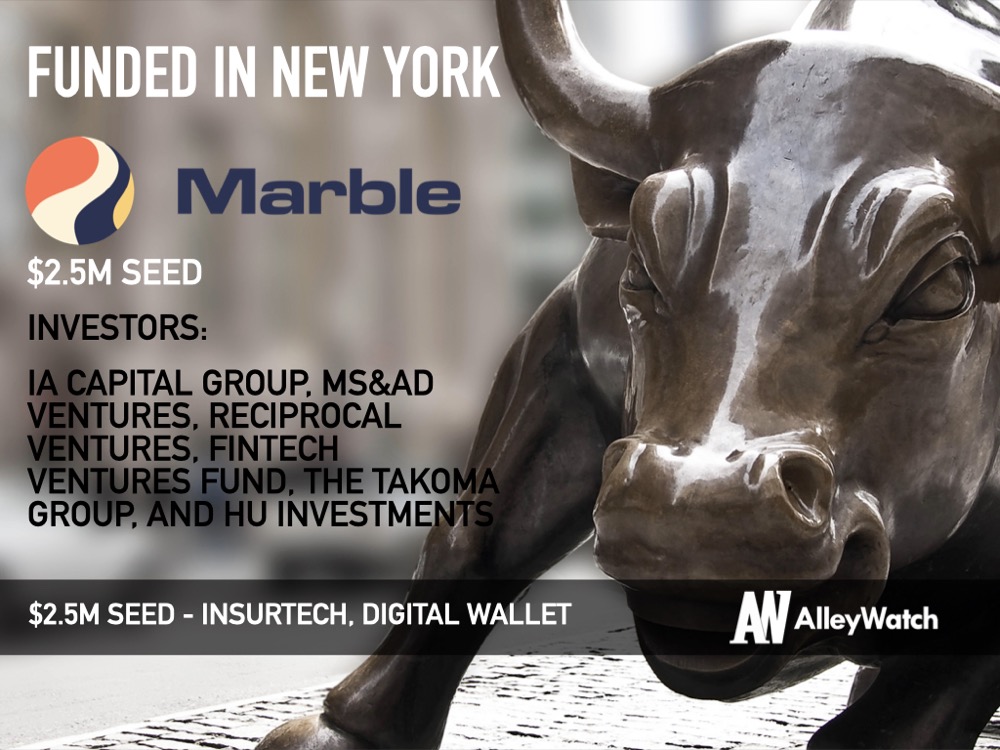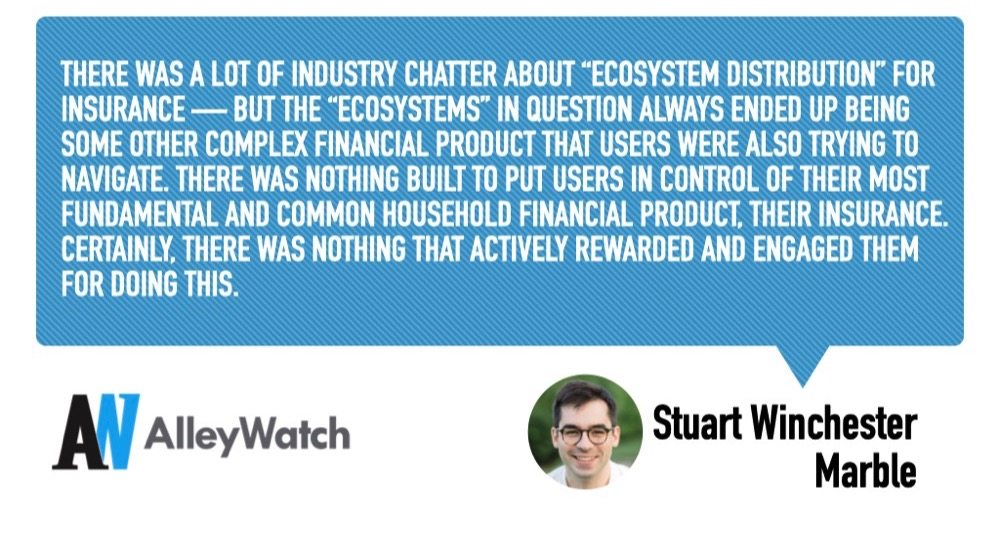Digital wallets have decentralized transactions across a variety of use cases and resulted in simplicity for consumers, with a sole point to manage their finances. 92% of Americans have some form of personal insurance yet there has not been a digital wallet solution for the insurance industry. Marble is a free digital wallet for consumers to manage all their insurance policies in a single place. The startup also offers rewards (up to 5%) for premium payments, saving consumers money. The insurance industry has been extremely competitive with digital-savvy consumers armed with comparison tools to save money on their premiums that are willing to jump carriers more so than ever before. In 2019, 48% of auto insurance holders said they would “definitely renew” with their carrier. That’s down from 59% in 2004. With carriers facing these challenges in retention and looking to attract the next generation of insurance buyers, Marble’s rewards platform increases loyalty and overall customer satisfaction. The company is in beta and plans to accommodate insurance policies from any carrier next month.
AlleyWatch caught up with CEO and Founder Stuart Winchester to learn more about the company’s launch, the state of the insurance market, and the company’s seed funding round.
Who were your investors and how much did you raise?
We’re proud to have raised $2.5 million in seed round funding from some of the most experienced insurance and fintech investors operating today. With firms like IA Capital Group, MS&AD Ventures, Reciprocal Ventures, Fintech Ventures Fund, The Takoma Group, and HU Investments investing in Marble’s seed round, we’re off to a great start.
Tell us about the product or service that Marble offers.
For the hundreds of millions of insurance customers in the US, Marble is the first digital wallet and loyalty platform for insurance. Marble is a one-hub, digital insurance wallet where our members can seamlessly manage all of their personal insurance details, documents, and payments — without having to switch between multiple apps and log-ins. We also provide rate shopping within the Marble platform, blocking any spam, and avoiding another multi-tab, frustrating insurance shopping experience.
Marble is also the first and only platform that allows you to earn rewards on your insurance, which you can redeem in a variety of ways, including towards premium payments. There are billions of dollars in the insurance marketing and acquisition ecosystem, most of it wasted and none of it going toward helping the customer. Marble works to pull those dollars out of advertising and into our rewards program.
We are also thrilled to be working with a number of top-15 national insurance carriers to offer the same comprehensive suite of tools that we use to power our members’ experience, with the goal of driving continuous digital engagement for their customers on their terms.
What inspired the start of Marble?
In 2018 I helped launch Better.com’s first drive into insurance, and for the next year or so I was fortunate to lead that business, Better Cover. While there, I partnered with some exceptional insurtechs like Hippo and Lemonade, and I also got to know great insurtech founders like the team at Young Alfred.
That experience really opened my eyes to a bunch of realities about the current state of insurance for the American consumer (it also involved spending like, 3 weeks in a windowless classroom getting licensed as an insurance agent).
I saw insurers directing huge amounts of money into marketing and acquisition campaigns, often just to win back the same customers they served two policies ago. Premiums were increasing year over year, and while the “selling” of insurance was going digital, not much else was getting easier or clearer for the end customer.
Around the same time, there was a lot of industry chatter about “ecosystem distribution” for insurance — but the “ecosystems” in question always ended up being some other complex financial product that users were also trying to navigate. There was nothing built to put users in control of their most fundamental and common household financial product, their insurance. Certainly, there was nothing that actively rewarded and engaged them for doing this.
That line of thinking led me to Andy Lerner and IA Capital in 2019. After a couple of breakfast meetings (in the before times) with Andy, the vision for Marble started to come together. In December 2019, Marble was officially founded.
How is Marble different?
For the last decade, nearly all customer-facing insurance innovation has gone towards tools and products that sell more insurance, faster. This has not always ended up being a good thing for the consumer.
Marble’s goal, and what makes us different, is that we put users back in control of the most crucial and common household financial product: insurance. We do that by helping them manage, pay, and earn up to 5% back on their existing insurance policies, all in one seamless digital wallet.
Make an account with Marble, get your insurance organized, and step away! That’s fine by us. Our product is not built to rush you through a sales funnel and then hammer you with emails and texts about insurance quotes you never wanted. Check-in with Marble a few weeks after signup, tell us if anything has changed, read some insider tips, and hop back out. We’re with you.
What market does Marble target and how big is it?
If you have insurance, you need Marble. Marble is here for the 92% of Americans who are insurance customers and want support in dealing with their insurance and insurance companies.
What’s your business model?
We make money in a few different ways. The primary channels today are: via referrals when our members decide to shop (and not before); a portion of the payments’ interchange that we assist with; and SaaS-like revenue from our enterprise partners.
How has COVID-19 impacted the business?
We believe that COVID-19 has only increased the need for a product like Marble. With the uncertainty of the past year, it’s never been more important to know that you’re protected – which is, after all, the primary goal of getting insurance. We built Marble so our members can feel safe and confident that their insurance is actually protecting them when they need it most.
I think COVID-19 has also raised consumer’s awareness around the costs and benefits of insurance, particularly as insurers have made various well-intentioned attempts at offering refunds in response to decreased driving. We recently took a look at this, and necessarily kept up. We’re seeing a lot of enthusiasm from our members because we help them stay on top of real-time topics like this.
What was the funding process like?
It wasn’t the most fun thing I’ve ever done. It was a ton of time on Zoom (73 hours), a lot of time trying to shoo my very beautiful and very dumb cat off my desk, and a good amount of learning on the job — I’m very thankful for two of those three things.
Everything started to really click in late 2020 as our earliest beta users began setting up their accounts. Once we were able to show the utility of the platform, and the engagement that our rewards program was able to drive, the process picked up speed.
What are the biggest challenges that you faced while raising capital?
I met a ton of very sharp VCs. Some were deeply versed in the more anachronistic parts of insurance regulation and others brought their own remarkable track records as operators.
One of the biggest challenges was navigating between these two types of investors, and more generally getting a better understanding of the early-stage investment landscape. I found that once an investor understood that Marble is creating an entirely new category within insurance, leveraging patterns and technology from other verticals, they got really excited.
One of the biggest challenges was navigating between these two types of investors, and more generally getting a better understanding of the early-stage investment landscape. I found that once an investor understood that Marble is creating an entirely new category within insurance, leveraging patterns and technology from other verticals, they got really excited.
What factors about your business led your investors to write the check?
It consistently came down to three core reasons, across all of our investors:
- Marble is a category creator. We’re doing something truly novel in a space that saw its last major surge of innovation in 2016 (if that). As one investor put it in an email, “We’ve spent a lot of time looking at this space and don’t see things that are as innovative as Marble very often. Really impressive.”
- There’s a massive need for new engagement and incentive channels in insurance. Retention and satisfaction are dropping, while premiums are just going up.
- Our team. We’ve been able to put together a team of truly best-in-class NY fintech professionals (seriously, this is our not-so-secret weapon).
What are the milestones you plan to achieve in the next six months?
Next up, we’ll be opening our digital insurance wallet in a public beta this March. We’re looking forward to welcoming the thousands of interested members off our waitlist. Right now we’re forecasting just over 20,000 members on the platform by early summer.
Then this spring, we’ll start launching our first enterprise partnerships, leveraging Marble’s flexible API backend to help national insurance carriers drive engagement and retention. A big portion of our fundraise investment will allow us to respond to the surge of inbound interest we’ve seen from carriers and brokers alike. Now we’ll be able to confidently resource against additional integrations through 2021.
Finally, we’ll also continue to invest in top talent to grow our team.
What advice can you offer companies in New York that do not have a fresh injection of capital in the bank?
Build a bulletproof financial model, or find someone that can. I started my career at a company called Accordion where, working with a team of former bulge bracket bankers, I quickly had to learn how to build (or break) a financial model.
I’ve tried my best to keep that skill sharp; unfortunately, I’ve seen or heard about plenty of NY companies that have stumbled without it. Either they run out of cash far, far sooner than expected, or they miss a key KPI until it’s way too late. Having a great model and staying really disciplined about keeping it up to date is a habit I’ll always maintain.
Where do you see the company going now over the near term?
Well, when it’s safe to gather, I cannot wait to get the team together in person. That’s the main thing on my mind. That also means I’ll be able to ride the subway daily again – that’s big for me.
In terms of business goals, I see two things happening in the next 6 months or so:
- Welcoming thousands of new members to Marble, getting them set up and in control of their insurance.
- Delivering for our enterprise partners and giving them the tools they need to engage with modern insurance customers.
What’s your favorite outdoor dining restaurant in NYC
We’ll go anywhere that our Operations Associate Tiffanie Qian (@millennialfoodienyc) recommends.
As for me, I have to recommend Mamas Too pizza up in my neighborhood. There’s been a lot of chatter about pizza recently and as a born and raised New Yorker, I think Mamas is up there with the best.






